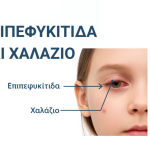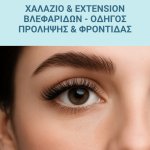
Pilocarpine = ciliary muscle stimulator Ophthalmogen = ciliary muscle supporter
Summary
Pilocarpine (ophthalmic solution) induces ciliary muscle contraction and miosis, temporarily improving depth of field and near vision in selected patients (e.g., presbyopia).
For this effect to be optimal — and for the eyes to feel truly “relaxed” — a healthy tear film and properly functioning meibomian glands are essential.
Here, Dermophthalmology and the Ophthalmogen line come into play: daily eyelid and eyelash hygiene, thermotherapy at 40°C for 20 minutes, Demodex monitoring, and lipid layer support. This combination can maximize visual benefit and comfort.
1) What Pilocarpine Does
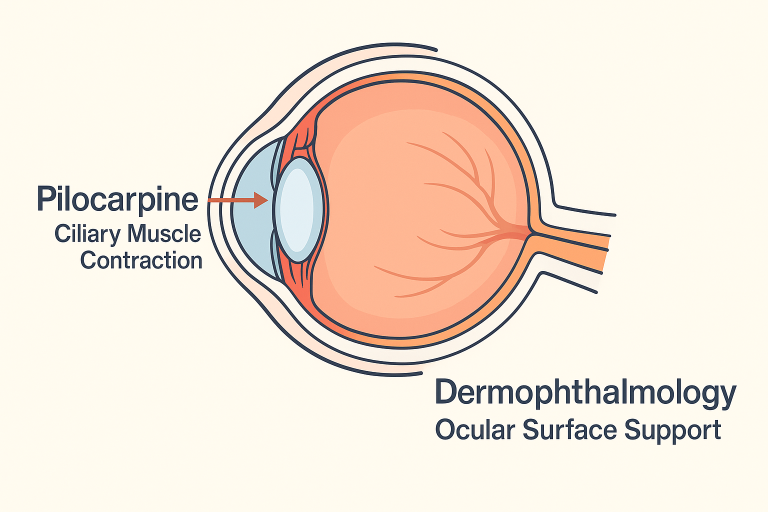
- Mechanism: Acetylcholine mimic → ciliary muscle contraction (boosts accommodation) & miosis (reduces spherical aberrations) → deeper near focus.
- Indications: Selected use in presbyopia/near vision needs.
- Limitations: Effect is temporary. Visual comfort and stability depend on ocular surface health (MGD, blepharitis, dry eye).
- Common side effects: headache, mild accommodative spasm, reduced night vision due to miosis, occasional blur or irritation.
- Medical advice: Only under ophthalmologist supervision, especially with history of uveitis, retinal detachment, or narrow angles.
2) Vuity: A New Hope for Presbyopia
Vuity is the first FDA-approved eye drop for presbyopia in the US, based on pilocarpine.
As early as 2020, on the Greek TV program Ora Metamorfosis with GlykeriaTsitsoni, Dr. Marguerite McDonald explained that a single daily drop can improve near and intermediate vision for 6–10 hours, through ciliary muscle contraction and miosis.https://www.youtube.com/watch?v=zvesuV7hqas&t=2s)
Moreover, Dr. McDonald has stated in international medical press that she was among the first ophthalmologists in the US to prescribe hundreds of Vuity treatments to her patients immediately after its launch (source).

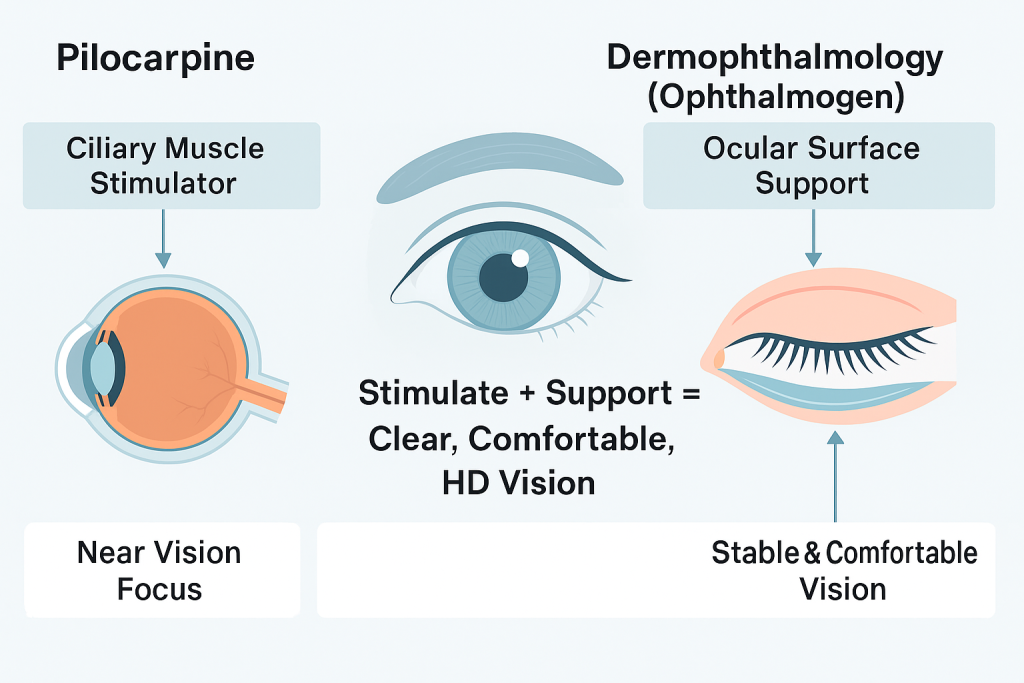
She emphasized that the effect is transient and largely depends on the ocular surface condition..
Therefore, combining pilocarpine therapy with daily Dermophthalmology care (Ophthalmogen) ensures maximum clarity, comfort, and stability of vision.
“Ophthalmogen is an excellent example of modern eyelid hygiene practice, especially before cataract surgery. Preparing the ocular surface is as important as the surgery itself.”
– Dr. Marguerite McDonald, Ora Metamorfosis (2020)
Tear film quality (especially the lipid layer from meibomian glands) determines visual clarity, comfort, and stability.
- MGD / Blepharitis / Demodex → unstable tear film, fluctuating blur, irritation.
- Even with a strong “stimulus” (pilocarpine), if the lids-lashes-lipids system fails, vision quality will decline during the day.

4) Ophthalmogen = Ciliary Muscle Supporter (via the ocular surface)
Goal: to keep the «ocular surfacehigh–definition» so that pilocarpine’s stimulus translates into consistently clear vision.
Dermophthalmology Hygiene Protocol
- Thermal therapy with Ophthalmogen EYE10: 40°C, 20 minutes daily, to liquefy thickened meibum and decompress the glands.
- Massage with Ophthalmogen Gel (eyelid ointment) to remove biofilm & oily debris.
- Cleanse the eyelids with Naviblef
- Disinfection / Demodex control with Ophthalmogen Spray at lash roots (morning & evening).
- Meibomian gland evacuation (as needed) by a specialist with Ophthalmogen Meibo Evacuators.
- Adjunct artificial tears (3–4×/day or as needed):
- Visionlux Plus (HA + vitamins A & E) → hydration + antioxidant protection.
- Thealoz Duo, Systane → tear film stabilization.
- Refresh Tears, Tears Naturalle → widely used classic options.
- o Flora Vision spray→ A pioneering choice – the 1st artificial tear in spray form, for easy and instant ocular hydration without drops.
Formula: Stimulate (Pilocarpine) + Support (Ophthalmogen) = clear, comfortable, stable vision throughout the day..
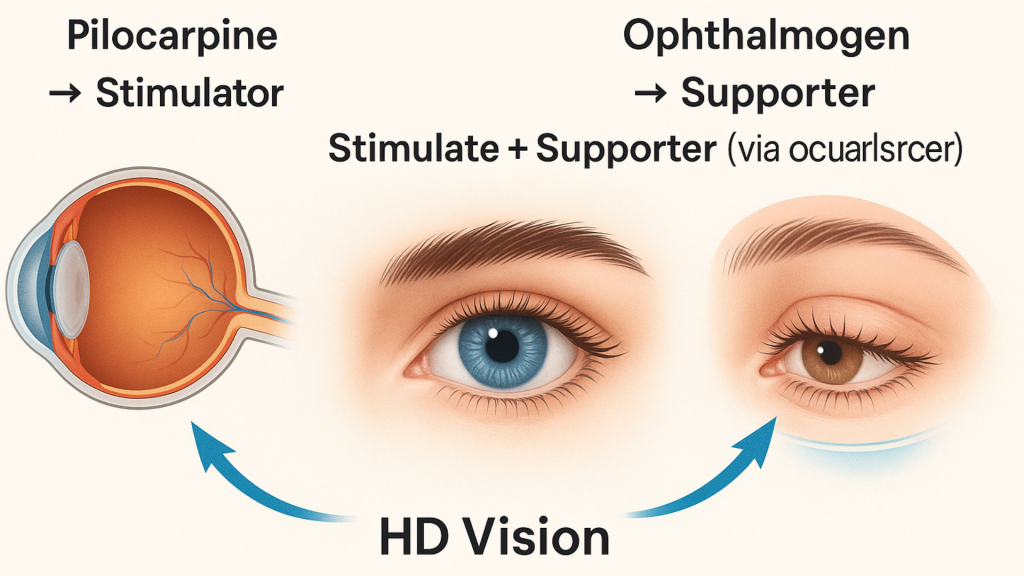
5) Practical Usage Tips (Combined Approach)

- Begin/continue daily hygiene (steps 1–4) for 2–4 weeks: many patients report clearer, more stable vision.
- Use artificial tears during screen breaks (20-20-20 rule).
- If starting pilocarpine for near tasks, avoid night driving initially (due to miosis) until you see how it affects you.
- Contact lens wearers: extra emphasis on eyelid hygiene to reduce deposits and intolerance.
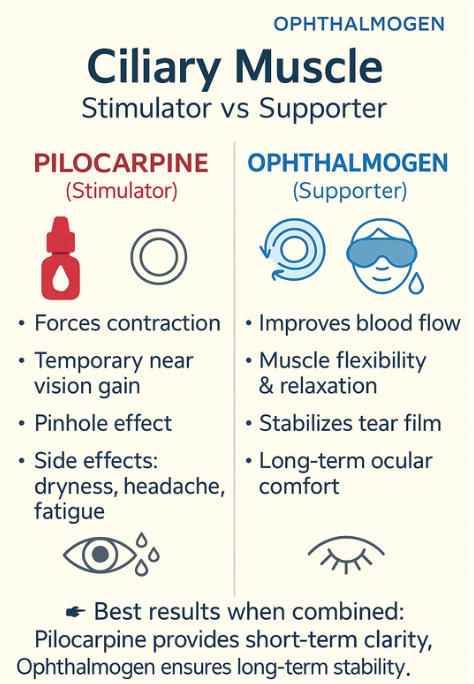
6) Frequently Asked Questions
Does pilocarpine cure blepharitis?
No. Pilocarpine is an optical tool. Blepharitis/MGD requires daily care (Ophthalmogen protocol).
How soon will I notice improvement?
Many patients report an “HD-like” effect after 2–3 weeks of consistent care.
Can I use artificial tears along with pilocarpine?
Yes — 3–4×/day depending on symptoms.
Are there risks with pilocarpine?
Yes. It should only be used under ophthalmologist supervision. There are contraindications and possible side effects.
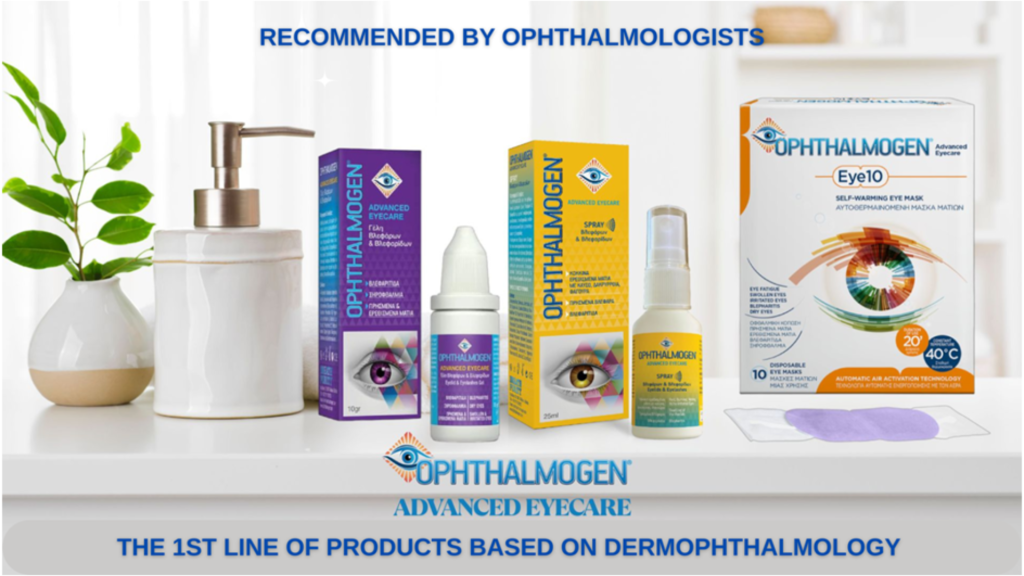
7) Disclaimer
This article is for educational purposes only. Any pharmaceutical treatment (e.g., pilocarpine) must be used under ophthalmologist supervision. Dermophthalmology protocols are customized to individual patient needs.
Step into the world of Dermophthalmology – get informed now! (dermophthalmology.com)

